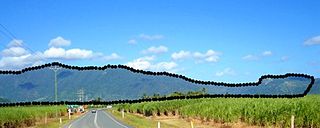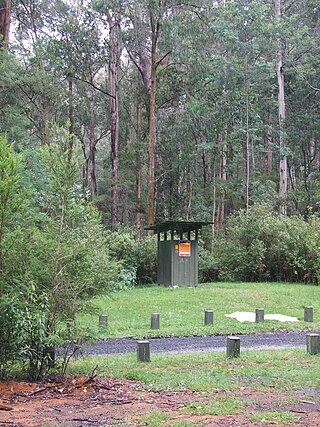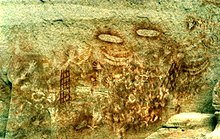
The bunyip is a creature from the aboriginal mythology of southeastern Australia, said to lurk in swamps, billabongs, creeks, riverbeds, and waterholes.

The koala, sometimes called koala bear, is an arboreal herbivorous marsupial native to Australia. It is the only extant representative of the family Phascolarctidae and its closest living relatives are the wombats. The koala is found in coastal areas of the mainland's eastern and southern regions, inhabiting Queensland, New South Wales, Victoria, and South Australia. It is easily recognisable by its stout, tailless body and large head with round, fluffy ears and large, spoon-shaped nose. The koala has a body length of 60–85 cm (24–33 in) and weighs 4–15 kg (9–33 lb). Fur colour ranges from silver grey to chocolate brown. Koalas from the northern populations are typically smaller and lighter in colour than their counterparts further south. These populations possibly are separate subspecies, but this is disputed.

Australian Aboriginal religion and mythology is the sacred spirituality represented in the stories performed by Aboriginal Australians within each of the language groups across Australia in their ceremonies. Aboriginal spirituality includes the Dreamtime, songlines, and Aboriginal oral literature.
Folk memory, also known as folklore or myths, refers to past events that have been passed orally from generation to generation. The events described by the memories may date back hundreds, thousands, or even tens of thousands of years and often have a local significance. They may explain physical features in the local environment, provide reasons for cultural traditions or give etymologies for the names of local places.

The term Australian megafauna refers to the megafauna in Australia during the Pleistocene Epoch. Most of these species became extinct during the latter half of the Pleistocene, and the roles of human and climatic factors in their extinction are contested.

A goanna is any one of several species of lizard of the genus Varanus found in Australia and Southeast Asia.

Yowie is one of several names for an Australian folklore entity that is reputed to live in the Outback. The creature has its roots in Aboriginal oral history. In parts of Queensland, they are known as quinkin, and as joogabinna, in parts of New South Wales they are called Ghindaring, jurrawarra, myngawin, puttikan, doolaga, gulaga and thoolagal. Other names include yahweh, noocoonah, wawee, pangkarlangu, jimbra and tjangara. Yowie-type creatures are common in Aboriginal Australian legends, particularly in the eastern Australian states.

Australian folklore refers to the folklore and urban legends that have evolved in Australia from Aboriginal Australian myths to colonial and contemporary folklore including people, places and events, that have played part in shaping the culture, image and traditions that are seen in contemporary Old Australia.
In Australian folklore, the Queensland tiger is a creature said to live in the Queensland area in eastern Australia.

Yowie is a confectionery brand originating in Australia in 1995. First produced by Cadbury under licence from Kidcorp, it was one of the top selling chocolates in Australia in the late 1990s and early 2000s, selling over a million units a week. After a break of nearly a decade, Yowie was relaunched in 2014 for US markets. The brand had been acquired by a Perth-based Australian company, the Yowie Group, in 2012. The chocolates reemerged in the Australian and New Zealand markets in 2017.

Koala emblems and popular culture deals with the uses which have been made of the image of the Koala, such as coins, emblems, logos, mascots and in the naming of sports teams.
Mythic humanoids are legendary, folkloric, or mythological creatures that are part human, or that resemble humans through appearance or character. Each culture has different mythical creatures that come from many different origins, and many of these creatures are humanoids. They are often able to talk and in many stories they guide the hero on their journey.

Bunyip State Park is a 166-square-kilometre (64 sq mi) state park 65 kilometres (40 mi) east of Melbourne, near the town of Gembrook, in the southern slopes of the Great Dividing Range within the Australian state of Victoria.

The drop bear is a hoax in contemporary Australian folklore featuring a predatory, carnivorous version of the koala. This imaginary animal is commonly spoken about in tall tales designed to scare tourists. While koalas are typically docile herbivores, drop bears are described as unusually large and vicious marsupials that inhabit treetops and attack unsuspecting people that walk beneath them by dropping onto their heads from above.

Dreamworld Corroboree is a collection of wildlife attractions at the Dreamworld amusement park on the Gold Coast, Queensland, Australia. The area is divided into several subsections which allow guests to view the animals in their natural habitats. Dreamworld Corroboree is a registered zoo with 800 native and barnyard animals located within the Dreamworld grounds.
Tim the Yowie Man is an Australian writer, author and cryptonaturalist who was born in Canberra, Australian Capital Territory.
Garkain is a legendary creature in Australian Aboriginal mythology said to haunt the dense jungle along the Liverpool River in the Northern Territory, Australia. Should an unwary traveller enter his domain, Garkain swoops down from the trees on his leathery wings and envelops them. It is a story parents tell to their children to tell them to not use physical violence as a way to solve problems.













